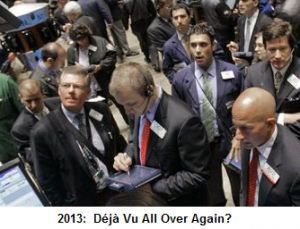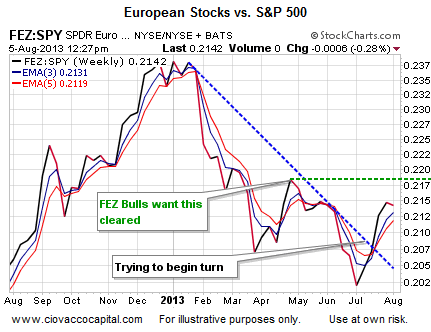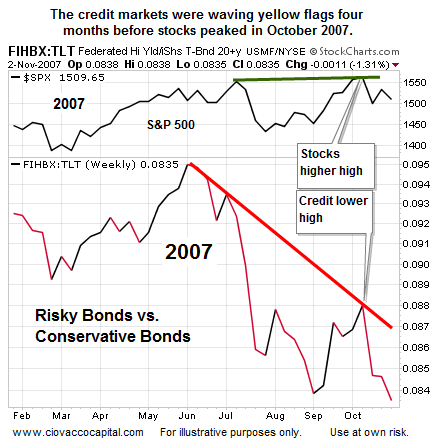After seeing stocks drop over 50% in both the 2000-2003 and 2007-2009 bear markets, investors are understandably hesitant to redeploy their hard-earned money back into stocks. Given the up and down nature of the markets over the last three years, many assume a major peak in stocks must be right around the corner. Is there evidence to support an imminent 2007-like peak in stocks?
 Economy Not On Ropes
Economy Not On Ropes
The global economy is far from robust currently, which has created lingering doubts. However, bear markets are typically associated with recessions. Monday’s economic news does not align with a negative growth story. From Bloomberg:
Service industries in the U.S. expanded in July at the fastest pace in five months, a sign the world’s biggest economy will improve after slowing the last three quarters. The Institute for Supply Management’s non-manufacturing index increased to 56, exceeding all forecasts in a Bloomberg survey, from a more than three-year low of 52.2 in June, a report from the Tempe, Arizona-based group showed today. The median estimate called for a gain to 53.1. Readings higher than 50 indicate growth in the industries that make up almost 90 percent of the economy.
Are The Credit Markets Hinting At A Peak In Stocks?
There is an adage on Wall Street that says the bond market is smarter than the stock market. One example to back up that theory came as the stock market was peaking in 2007. The main portion of the chart below shows the performance of junk bonds relative to more conservative Treasuries. The S&P 500 is shown at the top of the chart. When bond investors are confident about a low rate of default, they prefer to chase higher yields in junk bonds (ratio below rises). Conversely, when bond investors place a higher priority on “getting their principal back”, Treasuries are in greater demand (ratio falls). The credit markets said “something is wrong” several months before the 2007-2009 bear market began.
2007 vs. 2013: Reasons To Be Concerned?
This week’s video takes four key areas of the markets, including credit, and compares 2007 to 2013 side by side. The analysis answers the question posed above; is there evidence to support an imminent 2007-like peak in stocks?
European Economy Tries To Stabilize
A good part of the skepticism concerning stocks that has accrued in recent years was related to the European financial crisis. In 2010, 2011, and 2012, it seemed like every time stocks started to look good again, some bad news from Europe would rain on the parade. According to the Wall Street Journal, things may be changing for the better:
The thaw in Europe’s long crisis could warm up its stock market Fresh survey data suggest the 17-country euro zone may be edging out of a long recession, even if just barely. Some favorable winds are blowing. European stocks are still relatively inexpensive. The companies behind them generate plenty of cash and pay solid dividends. And Europe itself is less of a worry than one might think: European companies, especially big ones, generate a greater proportion of sales outside Europe than their U.S. peers do overseas.
Until recently, European stocks have been lagging the S&P 500 noticeably in 2013. As shown in the chart below, the Euro Stoxx 50 (FEZ) has been gaining ground on the S&P 500 in recent weeks. We have not allocated any capital back to Europe yet, but we do have several European ETFs on our watch list.

Investment Implications
As outlined in detail in the video above, the present day tolerance for risk is much healthier than it was in October 2007. While the global economy is far from robust, it does not appear to be on the cusp of a bear market inducing recession. Therefore, unless conditions on the economic and technical fronts deteriorate in a meaningful way, we will continue to hold our broad positions in U.S. stocks (SCHB), and leading sectors, such as financials (XLF), technology (QQQ), small caps (IWM), and mid-caps (MDY).
This article was originally published here by Ciovacco Capital and reprinted by permission.

Speak Your Mind